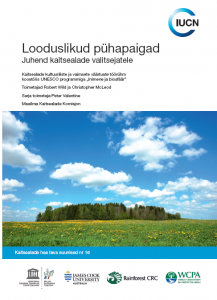
San Eastóin, timpeall 2500 láithreáin traidisiúnta nádúrtha naofa, chlúdaíonn réimsí mór talún is eol go bhfuil spioradálta suntasach, luachanna oidhreacht chultúrtha agus nádúrtha. Tá tuilleadh taighde agus doiciméadú ag súil go nochtann líonra de a oiread agus is 7000 suíomh nádúrtha naofa sa tír ina n-aonar.
 Le tacaíocht ó Aireacht Eastóinis an Chomhshaoil an NGO “Teach Eastóinis de Taara agus Reiligiúin Dúchasacha (Cumann Maavalla na Neamh-Chríostaithe agus Maausulis)” aistrithe an UNESCO IUCN “Láithreáin Nádúrtha Naofa, Treoirlínte do Bhainisteoirí Ceantair Chosanta” san Eastóinis. Maavalla Koda i gcomhar le hinstitiúidí comhshaoil stáit anois in ann úsáid a bhaint as na Treoirlínte aitheantas a fheabhsú, cosaint agus cur chun cinn na suíomh nádúrtha naofa. Beidh na Treoirlínte cur i bhfeidhm an Aireacht ar phlean caomhnaithe cultúir náisiúnta do shuímh nádúrtha naofa agus tabharfar tacaíocht oiliúna d'oifigigh stáit agus chaomhnóirí na láithreán nádúrtha naofa. Chun na críche sin bunaíodh grúpa tacaíochta ag 17 baill na parlaiminte Eastóinis in earrach na bliana 2011.
Le tacaíocht ó Aireacht Eastóinis an Chomhshaoil an NGO “Teach Eastóinis de Taara agus Reiligiúin Dúchasacha (Cumann Maavalla na Neamh-Chríostaithe agus Maausulis)” aistrithe an UNESCO IUCN “Láithreáin Nádúrtha Naofa, Treoirlínte do Bhainisteoirí Ceantair Chosanta” san Eastóinis. Maavalla Koda i gcomhar le hinstitiúidí comhshaoil stáit anois in ann úsáid a bhaint as na Treoirlínte aitheantas a fheabhsú, cosaint agus cur chun cinn na suíomh nádúrtha naofa. Beidh na Treoirlínte cur i bhfeidhm an Aireacht ar phlean caomhnaithe cultúir náisiúnta do shuímh nádúrtha naofa agus tabharfar tacaíocht oiliúna d'oifigigh stáit agus chaomhnóirí na láithreán nádúrtha naofa. Chun na críche sin bunaíodh grúpa tacaíochta ag 17 baill na parlaiminte Eastóinis in earrach na bliana 2011.
Tá na Treoirlínte ar líon na 16 sa Choimisiún Domhanda ar Limistéir Chosanta’ Sraith Cleachtas is Fearr (léargas anseo) agus tá forbairt déanta ag an ngrúpa Saineolaí ar Luachanna Cultúrtha agus spioradálta de Limistéir chosanta. "Tá na Treoirlínte i éileamh ard. Ó seoladh ag an Domhain IUCN Caomhnaithe Comhdháil i 2008 siad a bheith aistrithe ón mBéarla go Rúisis, Spáinnis agus Eastóinis agus leaganacha Fraincise agus Seapánacha á ndéanamh” a deir an tUas. Robert Fiáin, comhúdar na dTreoirlínte agus cathaoirleach ar CSVPA. Le tacaíocht ón WCPA agus ón gCiste Christensen tá na Treoirlínte á n-aistriú faoi láthair, thástáil, athbhreithniú agus a leathnú le cás-staidéir nua ag an Tionscnamh Láithreáin Naofa Nádúrtha.
Tá cás na hEastóine maidir le caomhnú láithreán nádúrtha naofa ar cheann de thart 35 cásanna atá mar chuid de na Delos Tionscnamh, tionscnamh a oibríonn chun feabhas a chur ar chaomhnú láithreán nádúrtha scanraithe i dtíortha forbartha teicneolaíochta. “Le linn an tríú ceardlann den Tionscnamh Delos in Inari i 2010 D’fhoghlaim mé faoi iarrachtaí Ghrúpa Speisialtóirí IUCN ar Luachanna Cultúir agus spioradálta chun láithreáin nádúrtha naofa a chosaint agus a chaomhnú ar fud an domhain.. Thuig mé go mbeadh na Treoirlínte IUCN UNESCO a bheith ina uirlis an-éifeachtach chun láithreáin nádúrtha naofa a chaomhnú san Eastóin” a deir an tUasal. Atho Kaasik an elder de Maavalla Koda.
Cé nach bhfuil achar iomlán na hEastóine níos mó ná 47.000 KM2, tá go leor réimsí teanga agus cultúrtha éagsúla le fáil laistigh dá chríoch, agus mar sin tá éagsúlachtaí réigiúnacha i gcineálacha agus ainmneacha na suíomhanna nádúrtha naofa freisin. Mar shampla, tá carraigeacha agus crainn a úsáidtear le haghaidh leighis coitianta in iarthar na tíre. Láithreáin phobail ar a bhfuil an t-ainm na (garrán naofa) atá scaipthe i gcodanna thuaidh agus thiar na tíre. Is in Oirdheisceart na hEastóine amháin a chaomhnaítear traidisiún na gcros-chrainn a bhaineann le nósanna sochraide.
Ó thaobh níos leithne de, Tá láithreáin nádúrtha naofa Eastóinis mar chuid de thraidisiúin láithreán naofa Fenno-Ugric. Ar chúiseanna stairiúla, reiligiún traidisiúnta na hEastóine oirsc tar éis teacht chun cinn den chuid is mó mar theaghlach, pearsanta agus faoi rún. Naofa nádúrtha Láithreáin a úsáidtear le haghaidh guí, leighis, ag iarraidh beannacht ar phósadh duine, ag tabhairt ainm do leanbh, comhairleoireacht, tairiscintí a dhéanamh agus deasghnátha éagsúla a dhéanamh, go háirithe ar laethanta naofa an fhéilire tíre. Sa lá atá inniu, láithreáin nádúrtha naofa atá faoi bhagairt díothaithe go príomha mar gheall ar easpa rialachán dlíthiúil agus feasacht ar láithreáin nádúrtha naofa.






